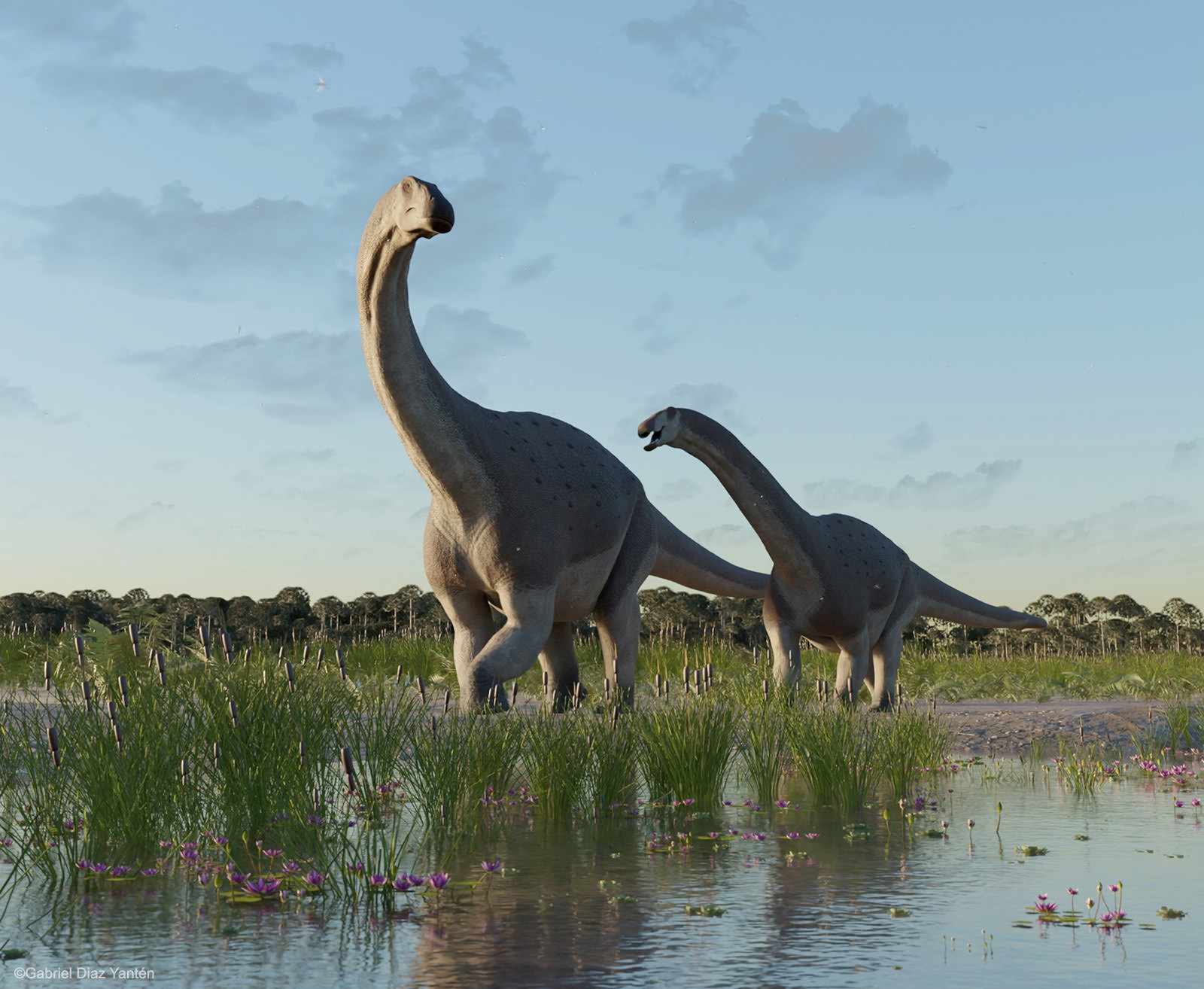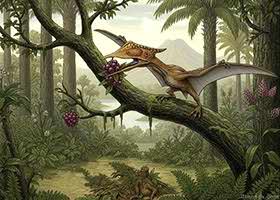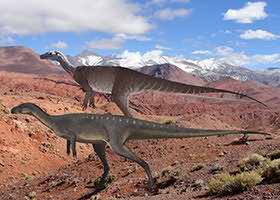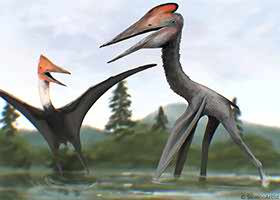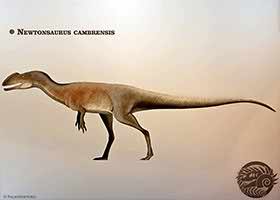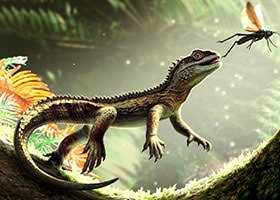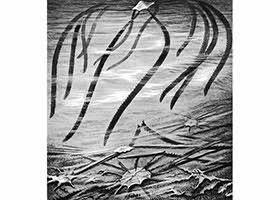
Scientists found the earliest fossils of basal tetrapodomorphs in the Early Devonian of China (Yunnan). These are Tungsenia paradoxa—409 mya (Pragian) and Kenichthys campbelli—395 mya (Emsian). They are the first known fish-like sarcopterygian ancestors of all tetrapods. They were at the very beginning of a long path that led their descendants to develop lung breathing, transform paired fins into true limbs, and ultimately to emerge onto land and conquer the earth.
Tungsenia

Tungsenia, from the basal tetrapodomorphs. This small fish is the earliest known stem tetrapod. It is known from fragments of the skull. ©Tamura
† Tungsenia paradoxa. Jing Lu et al., 2012. Early Devonian, Pragian (409 mya), China, Yunnan Province, Zhaotong, Posongchong Formation. The generic name after paleoichthyologist Liu Tungsen. The specific name comes from the Latin paradoxus, unexpected.
Initially, researchers found a parietal shield and two lower jaws, followed by complementary specimens. The Posongchong fauna includes diverse galeaspid agnathans, placoderms, onychodonts, coelacanths, and rhipidistians.
Tungsenia is a small basal stem tetrapodomorph with cosmine scales. It appeared shortly after the supposed time of divergence of dipnoan fish and tetrapods. The body length is about 10 cm.

Basal tetrapodomorph Tungsenia. Holotype. Parietal shield in ventral (a—photo; b—line drawing) and ventrolateral (c—photo; d—line drawing) views. Right mandible in mesial view (e—photo, f—restoration).
add.fo—adductor fossa; art.e—ethmoid articulation; ar.Vo—vomeral area; c.hyp—canal for buccohypophysial duct; c.n.pro—canal for profundus branch of trigeminal nerve; cv—cranial cavity; c.v.pit—canal for pituitary vein; c.II—canal for optic nerve; c.III—canal for oculomotor nerve; fe.exa—fenestra exonarina anterior; fe.v—fenestra ventralis; fo.gl—glenoid fossa; fo.icor—intercoronoid fossa; fo.pcor—precoronoid fossa; ioc—infraorbital canal; la.Co—tooth pavement on the lateral portion of coronoids; my?—myodome for eye muscle attachment?; n.ioc—notch for infraorbital canal; n.Pmx—notch for premaxillary; np—notochordal pit; P—parasphenoid; p-mc—pores for mandibular canal; Prart—prearticular; pr.bp—basipterygoid process; soc—supraorbital canal; Sym—symphyseal area; t.Co—coronoid tusks; t.De—dentary teeth; te.o—orbital tectum; t.Psym—parasymphysial plate tusk. Scale bar: 1 mm.
The enlarged hemispheres (cerebral cavities) suggest that they appeared in Tetrapodomorpha at the initial stage of their evolution. Directly behind the cerebral cavity are the pineal and parapineal organs. However, unlike other rhipidistians (the lineage of dipnoans and tetrapods), these two organs do not protrude too far forward and do not form canal-like structures. The pineal foramen is located at the mid-level of the orbits. The olfactory tracts are short and robust.
The hypophysial fossa, as in Youngolepis and Powichthys, is stout and triangular, located far behind the optic nerve root. The hypophysial canal extends backward and opens its aperture on the parasphenoid, far from the exit of the optic nerve. In the anterior part of the hypophysial fossa, there are paired lingual depressions.
In the basal tetrapodomorph Tungsenia, the width of the parietal shield is approximately equal to its length. The mouth was subterminal. It has a large orbital notch, constituting ~40% of the total length of the parietal shield, which is the largest among such in stem tetrapods.

Tungsenia is a genus of basal tetrapodomorphs that lived 409 million years ago in China. It is considered one of the basalmost tetrapodomorph that has been found so far. ©Daeng Dino
Tungsenia resembles Kenichthys and basal dipnomorphs (e.g., Youngolepis and Powichthys) in the medio-ventrally directed snout, the suborbital sensory canal running along the suture between the premaxilla and adjacent bones, a broad orbital septum, and well-developed basipterygoid processes. The elongated, broad parasphenoid and paired internal nasal pits are common with primitive sarcopterygian Styloichthys and basal dipnomorphs, but differ from other stem tetrapods.
The teardrop-shaped recess is located anterodorsally to the eye socket. Many finned stem tetrapods, such as Gogonasus, Medoevia, Cladarosymblema, and Litoptychus feature a similar recess, serving as the attachment site for eye muscles.

Tungsenia is a tetrapodomorph from early Devonian China. This fish is one of the transitional animals between fish and tetrapods.
The large pair of fangs on the parasymphysial dental plate is comparable to that of stem tetrapods with limbs (for example, Ichthyostega and Acanthostega), but is absent in finned stem tetrapods. The composite cheek plate, consisting of fused squamosal, quadratojugal, and preopercular bones, is similar to that of the dipnomorph Youngolepis and some finned stem-tetrapods. The postorbital bone is large, as in the rhizodontid Barameda.
Tungsenia exhibits a mix of endocranial features previously found either in basal dipnomorphs or in tetrapodomorphs. This further fills the morphological gap between tetrapods and lungfish. The study of Tungsenia, the most basal stem tetrapod, has provided unique information about the initial stage of brain evolution in tetrapods.
Kenichthys

Kenichthys is a genus of basal tetrapodomorphs that lived during the Early Devonian Period in China. It is one of the first known tetrapodomorphs to possess a structure that is transitional between a fish-like nostril and choana. ©Daeng Dino
† Kenichthys campbelli. Chang & Zhu, 1993. Early Devonian, Emsian (399–395 mya), China, Yunnan province, Qujing district, Chuandong formation. Named for the Australian paleontologist Ken Campbell. It comes from the clade Rhipidistia. The site contains several specimens and numerous scales from different parts of the body.
Researchers initially assigned Kenichthys to the group Osteolepididae. Now, Kenichthys ranks as one of the most basal tetrapodomorphs fishes. The genus contains only one known species.
This small creature, measuring 10–12 cm in length, had a skull 2 cm long. Only the front part of the body has been preserved: the skull with the lower jaw and the shoulder girdle. But it seems likely that Kenichthys was similar in overall body shape to other basal sarcopterygians, having two dorsal fins, paired pectoral and pelvic fins, and an anal fin.

Kenichthys campbelli. Left: A—ethmosphenoid shield, holotype, in dorsal view; B—otoccipital shield, in dorsal view. Right: sketches in dorsal view. So2—posterior supraorbital; bli—blisters in areas of resorption; gp.so—groups of pores for cutaneous sensory organs; f.pi—pineal foramen; ap—anterior pit-line; od.Po area—at the lateral margin of skull roof overlapped by postorbital; mp—middle pit-line; pp—posterior pit-line; proc—preorbital corner; om—orbit margin; ptoc—postorbital corner; em.Po—postorbital embayment (anterior section of n.Po); pr.po—postorbital process; soc—supraorbital sensory canal; n.Po—postorbital notch; od.Eth— area on the otoccipital shield overlapped by the ethmosphenoid shield; i.Et—notch for extratemporal; Pa+It—parietal+intertemporal; St—supratemporal; Ta—tabular. ©Chang, Zhu
The study of Kenichthys helps to clarify the origin of the choana and establishes its homology: it is indeed a displaced posterior external nostril, which during a short transitional stage, illustrated by Kenichthys, and separated the upper jaw from the premaxillary bone.
The short snout bends downward. The preorbital portion of the ethmosphenoid shield is very short, but the postorbital portion of the ethmosphenoid shield is very long. The pineal foramen is at the level of the orbital corners. Around the foramen, pineal plates are absent. The squamosal, quadratojugal bones, and preoperculum are fused into a composite rectangular cheek plate with 3 pits. These pits lie near or on the margin of the plate.
The maxilla has an elongated triangular shape with a very small upper jaw process (processus maxillaris). Along its ventral edge, there is a row of marginal teeth. The maxilla is about five times as long as it is deep.

Kenichthys campbelli. Lower jaw in lingual view. Photo and sketch. ©Chang, Zhu
As.dp—adsymphysial dental plate; s.Co 1,2—socket for coronoid replacement tusks; t.Co 1,2—tusk of first or second coronoid; t.De—marginal teeth of dentary; la.Co—lateral portion of coronoids covered by small teeth; p.dplt—pit probably receiving tusk of dermopalatine; Prart—prearticular;
The lower jaw of Kenichthys is short and high (the length is about 4 times its height), with the coronoid and other teeth covered with thin longitudinal striations. On the lingual side of the mandibula, the teeth on the dentary are uniform. There are 3 coronoids with tusks on two of them. The tusks on the coronoids are slightly folded at the base and might be polyplocodont. Numerous small teeth of varying sizes cover the lateral parts of the anterior coronoids and the entire surface of the posterior coronoids. At the same time, the posterior ones are larger than the anterior ones. The outer side of the mandibula has a continuous cosmine covering, hiding the seams.
The adsymphysial dental plate carries numerous denticles or teeth. Denticles and small teeth cover the prearticular bone. The largest teeth located along its dorsal edge. At the rear end of the lower jaw, the prearticular bone is positioned almost perpendicular to the dentary and infradentaries.

Photographs and drawings of Kenichthys campbelli specimen. Ethmosphenoid in anterior (a, b) and ventral (c, d) views. Scale bar, 2 mm. ©Chang, Zhu
The opercular is square; its outer surface is slightly dome-shaped. The subopercular is rectangular, much longer than deep. The large posterior branchiostegal ray is longer than it is high. The principal gular plate is relatively short and wide. There is one small medial gular plate, which is a small rhombic bone; the anterior part is longer than the posterior.
In the shoulder girdle of this basal tetrapodomorph, the dorsal part of the cleithrum is rectangular.
Numerous isolated scales include: a hexagonal from the dorsal medial row, a rhombic from the lateral row, and one basal scute with a pit-line, which apparently belongs to the dorsal sensory line. On the inner side of the rhombic scale, there is a low ridge.
A continuous layer of very smooth cosmine with tiny pores covers the roof of the Kenichthys skull. There are no sutures between the parietal and intertemporal bones. The premaxillary bones, with a row of marginal teeth, have distinct sutures with the adjacent parts of the skull roof. The orbital notch is small and deep, located far forward in the anterior half of the ethmosphenoid shield. The cranial roof between the orbits is relatively wide.
Beginning of choana development in basal tetrapodomorphs
Most fish have two pairs of nostrils, one at each end of the nasal cavity. All of them are external and serve for smelling, not for breathing. There is no connection between the nasal cavity and the mouth. However, many tetrapodomorphs and all tetrapods have one pair of nostrils located outside and another inside, on the palate. The internal nostrils, called choanae, enable breathing through the nose.
With this system, a vertebrate could inhale air without the need to swallow it with its mouth. Instead, air can be drawn directly through the nostrils into the closed oral chamber, passing through the olfactory system along the way, and then pumped into the lungs.

Nostril positions on the heads of sarcopterygian fishes. a—reconstruction of Kenichthys campbelli head and cheek in lateral view. b, c—Kenichthys. d, e—Eusthenopteron. b, d are lateral views; c, e are ventral views. In c, the (unknown) vomer is represented by its attachment area on the ethmoid. Not to scale. Dpl—dermopalatine; Enp—, entopterygoid; La—lacrimal; l.Ro—lateral rostral; Mx—maxilla; Pmx—premaxilla; Te—tectal; Vo—vomer; ©Zhu, Ahlberg
Kenichthys, from the basal tetrapodomorphs, was at the very beginning of the evolutionary path from fish to tetrapods. Its posterior external nostrils have already changed their position and are located on the edge of the jaw, between the premaxillary bone and the upper jaw. A slit about 1 mm wide, which directly communicates with the nasal capsule, separated the premaxilla and maxilla. Thus, the posterior nostril was an opening in the upper lip. This means that the choanae of tetrapods developed by migration during a short transitional stage of the posterior external nostril around the jaw between the premaxillary and maxillary bones and up onto the palate. The nostril morphology of Kenichthys represents an ideal intermediate link between states with and without choanae.




